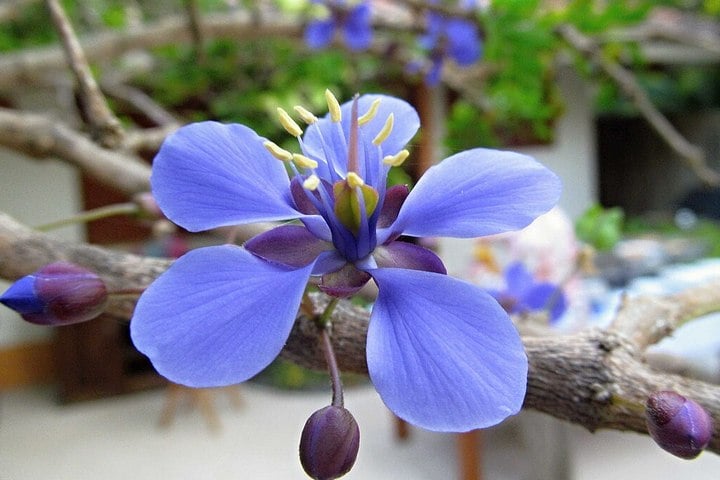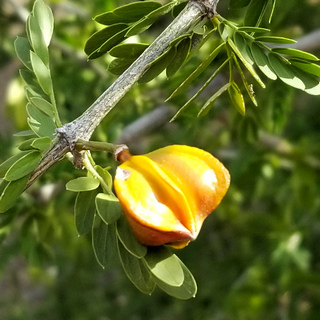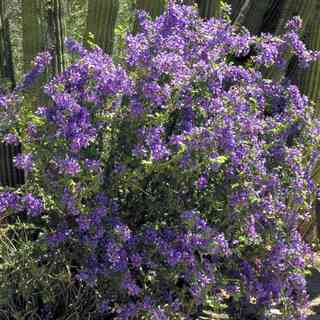Guayacan is a shrub that turns heads when in bloom. Its flowers are violet-blue, a color rarely seen in the desert. But the other notable feature of this stunning plant is less desirable — it’s incredibly slow-growing. Here’s everything you need to know about planting and caring for this Sonoran Desert native.

Guayacan (Guaiacum coulter) is a medium size shrub with twisted branches and violet-blue flowers with obvious yellow stamens. It is jaw-droppingly gorgeous when in bloom. The first time I saw it, I thought, “I have to have one!” That is, until I learned more about it. (This is why it sometimes pays not to impulse buy.)
There’s a problem with growing this as a landscape plant — it grows painfully slowly, as in “one inch per year” slow. According to the University of Arizona, it can take 60(!) years to reach a height of 5 feet in residential landscapes.
I haven’t got the time or patience for that, but I realize that not every gardener will mind. If you’re still game to grow one, here are some of the reasons to consider this truly stunning plant.
Why I Like This Plant
- Intensely showy violet-blue flowers
- Small but colorful gold fruit
- Willowy, weeping foliage
- Doesn’t outgrow its space
- Long-lived, well over 100
- Sonoran Desert native
- Extremely low maintenance
- No thorns, non-toxic, low litter
- Attracts butterflies, bees
Things to Watch Out For
Don’t expect guayacan to be available at ordinary garden centers. Your best bet will be nurseries that specialize in native plants. (In Tucson, Spadefoot Nursery sometimes carries them.)
Since they grow so slowly, I recommend buying the biggest specimen you can find or afford. Be prepared for sticker shock — they can be pricey.
This plant is borderline cold tolerant in places with regular winter freezes.

Optimal Growing Conditions
If you’re considering adding a guayacan to your garden, you need to find a suitable place that will keep your plant healthy and looking good… while minimizing maintenance for you.
Here are the key factors to keep in mind.
Temperature
Guayacan should be planted in USDA Hardiness Zones 9 – 11. It is extremely heat tolerant and cold-hardy down to 25℉. It will suffer cold damage when temperature dips into the twenties, but it should rebound in the spring. Cold damage is one of the factors that keeps this plant small in cultivation.
Sun Exposure
Guayacan is a sun-lover that looks its best in full sun. Leaves becomes sparse when grown in part shade.
Size and Growth Rate
Guayacan is an extremely slow grower, typically growing less than an inch per year. In cultivation, it usually tops out at a size of 5 to 10 feet tall and wide.
In its native habitat, it can reach 25 feet tall and wide, if it doesn’t freeze back in the winter and is left undisturbed. It often grows more tree-like than shrub-like since deer and other animals browse on the growth they can reach.
If conditions are right, it may grow 2″ per year. Here’s a picture of a 6 foot tall specimen at the Arizona-Sonora Desert Museum that is reportedly 30 years old.

Soil
Guayacan’s preference is to grow in gravelly, well-draining soil that has low organic content.
Guayacan:
The Essentials
| Common Name | Guayacan |
| Scientific Name | Guaiacum coulter |
| Origin | Mexico, Guatamala |
| Plant Type | Semi-deciduous shrub |
| USDA Zones | Zones 9 – 11 |
| Cold Hardiness | To 25℉ |
| Flower Color | Purple |
| Flower Season | Spring, summer, fall |
| Mature Size | 5-10′ tall x 5-10′ wide |
| Growth Rate | Extremely slow |
| Sun Tolerance | Full, part sun |
| Water Needs | Low |
| Garden Friendly | No thorns, non-toxic, low litter |
| Wildlife | Attracts bees, butterflies |
How to Plant
The rule of thumb when planting any shrub in the desert is to dig a hole three times as wide as the root ball but no deeper. Amending the soil is not recommended. Counterintuitively, backfilling with the same native soil you just dug up helps your plant develop a stronger root system.
When to Plant Guayacan
The best time to plant guayacan is in the fall. This gives your shrub three seasons to grow roots and get established before the following summer.
The second best time is in spring, the earlier the better. This still gives your plant time to get established before the intense heat of June arrives.
How to Care for Guayacan
Whether you’ve recently planted a guayacan or have an existing plant in your yard, here’s how to take care of it to keep it healthy and looking its best.
How to Water New Plants
Once you’ve got your guayacan planted, watering is your most immediate concern. Here is the recommended watering schedule for new shrubs planted in the spring or fall.
| Weeks 1 & 2 | Every 3 – 4 days |
| Weeks 3 & 4 | Every 5 – 7 days |
| Weeks 5 & 6 | Every 7 – 10 days |
| Weeks 7 & 8 | Every 10 – 14 days |
After week 8, gradually extend the time between waterings.
How to Water Established Plants
Once your plant is established, water it every 1 to 2 weeks during the summer and every 3 to 4 weeks in winter.
Should You Fertilize?
There is no need to fertilize guayacan. It is well-adapted to thrive in native desert soil. Top dressing with compost “may” speed up its growth.
How to Prune
Guayacan should not be pruned as a matter of course. The last thing you want to do is remove precious years of growth by pruning. So give your landscape explicit instructions to leave this plant alone.
However, you can prune any cold damage in early spring.
Skyflower: A Guayacan Alternative
If you love the look of guayacan, but doubt you’ll be content with a plant that barely grows, consider skyflower (Duranta erecta). It’s a sprawling shrub that is just as beautiful, with cascades of lavender flowers and yellow-orange berries. It’s not a desert native and needs a moderate (rather than low) amount of water, but it grows moderately fast.

Plant Lover Facts
Guayacan is native to Mexico and Guatemala. It is considered a “vulnerable” species in native habitat due to overharvesting for its extremely hard wood.
Did you enjoy this article?
Sign up for our weekly newsletter
where you’ll find more great info on creating &
maintaining a beautiful, carefree desert landscape.
Author Bio
Deane Alban is the creator of Southwest Gardener. She is a science writer with a bachelor’s degree in botany from the University of South Florida. Gardening is her lifelong passion. She’s been gardening in Tucson for over 15 years.

Photo Credits
Travelian, CC BY-SA 2.0, via Wikimedia Commons
Arizona State University’s Virtual Library of Phoenix Landscape Plants
Mokkie, CC BY-SA 3.0, Wikimedia Commons
